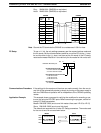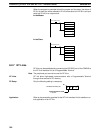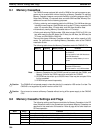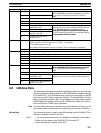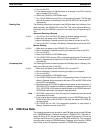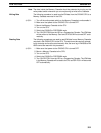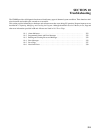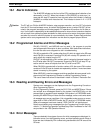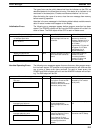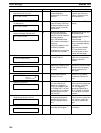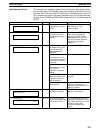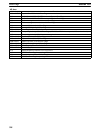
!
392
10-1 Alarm Indicators
The ALM/ERR indicator on the front of the CPU provides visual indication of an
abnormality in the PC. When the indicator is ON (ERROR), a fatal error (i.e.,
ones that will stop PC operation) has occurred; when the indicator is flashing
(ALARM), a nonfatal error has occurred. This indicator is shown in
2-1-1 CPU
Indicators
.
Caution The PC will turn ON the ALM/ERR indicator, stop program execution, and turn OFF all outputs
from the PC for most hardware errors, for certain fatal software errors, or when FALS(07) is exe-
cuted in the program (see tables on following pages). PC operation will continue for all other er-
rors. It is the user’s responsibility to take adequate measures to ensure that a hazardous situation
will not result from automatic system shutdown for fatal errors and to ensure that proper actions
are taken for errors for which the system is not automatically shut down. System flags and other
system and/or user-programmed error indications can be used to program proper actions.
10-2 Programmed Alarms and Error Messages
FAL(06), FALS(07), and MSG(46) can be used in the program to provide
user-programmed information on error conditions. With these three instructions,
the user can tailor error diagnosis to aid in troubleshooting.
FAL(06) is used with a FAL number other than 00, which is output to the SR area
when FAL(06) is executed. Executing FAL(06) will not stop PC operation or di-
rectly affect any outputs from the PC.
FALS(07) is also used with a FAL number, which is output to the same location in
the SR area when FALS(07) is executed. Executing FALS(07) will stop PC op-
eration and will cause all outputs from the PC to be turned OFF.
When FAL(06) is executed with a function number of 00, the current FAL number
contained in the SR area is cleared and replaced by another, if more have been
stored in memory by the system.
When MSG(46) is used a message containing specified data area words is dis-
played onto the Programming Console or another Programming Device.
The use of these instructions is described in detail in
Section 5 Instruction Set
.
10-3 Reading and Clearing Errors and Messages
System error messages can be displayed onto the Programming Console or
other Programming Device.
On the Programming Console, press the CLR, FUN, and MONTR keys. If there
are multiple error messages stored by the system, the MONTR key can be
pressed again to access the next message. If the system is in PROGRAM mode,
pressing the MONTR key will clear the error message, so be sure to write down
all message errors as you read them. (It is not possible to clear an error or a mes-
sage while in RUN or MONITOR mode; the PC must be in PROGRAM mode.)
When all messages have been cleared, “ERR CHK OK” will be displayed.
Details on accessing error messages from the Programming Console are pro-
vided in
7-1 Monitoring Operation and Modifying Data
. Procedures for the LSS
are provided in the
LSS Operation Manual
.
10-4 Error Messages
There are basically three types of errors for which messages are displayed: in-
itialization errors, non-fatal operating errors, and fatal operating errors. Most of
these are also indicated by FAL number being transferred to the FAL area of the
SR area.
Error Messages Section 10-4



